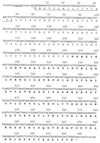Sequence analysis of scaffolding protein CipC and ORFXp, a new cohesin-containing protein in Clostridium cellulolyticum: comparison of various cohesin domains and subcellular localization of ORFXp
- PMID: 10074072
- PMCID: PMC93578
- DOI: 10.1128/JB.181.6.1801-1810.1999
Sequence analysis of scaffolding protein CipC and ORFXp, a new cohesin-containing protein in Clostridium cellulolyticum: comparison of various cohesin domains and subcellular localization of ORFXp
Abstract
The gene encoding the scaffolding protein of the cellulosome from Clostridium cellulolyticum, whose partial sequence was published earlier (S. Pagès, A. Bélaïch, C. Tardif, C. Reverbel-Leroy, C. Gaudin, and J.-P. Bélaïch, J. Bacteriol. 178:2279-2286, 1996; C. Reverbel-Leroy, A. Bélaïch, A. Bernadac, C. Gaudin, J. P. Bélaïch, and C. Tardif, Microbiology 142:1013-1023, 1996), was completely sequenced. The corresponding protein, CipC, is composed of a cellulose binding domain at the N terminus followed by one hydrophilic domain (HD1), seven highly homologous cohesin domains (cohesin domains 1 to 7), a second hydrophilic domain, and a final cohesin domain (cohesin domain 8) which is only 57 to 60% identical to the seven other cohesin domains. In addition, a second gene located 8.89 kb downstream of cipC was found to encode a three-domain protein, called ORFXp, which includes a cohesin domain. By using antiserum raised against the latter, it was observed that ORFXp is associated with the membrane of C. cellulolyticum and is not detected in the cellulosome fraction. Western blot and BIAcore experiments indicate that cohesin domains 1 and 8 from CipC recognize the same dockerins and have similar affinity for CelA (Ka = 4.8 x 10(9) M-1) whereas the cohesin from ORFXp, although it is also able to bind all cellulosome components containing a dockerin, has a 19-fold lower Ka for CelA (2.6 x 10(8) M-1). Taken together, these data suggest that ORFXp may play a role in cellulosome assembly.
Figures









References
-
- Bayer E, Lamed R. The cellulosome—a treasure-trove for biotechnology. Trends Biotechnol. 1994;12:379–386. - PubMed
-
- Bayer E A, Morag E, Lamed R, Yaron S, Shoham Y. Cellulosome structure: four-pronged attack using biochemistry, molecular biology, crystallography and bioinformatics. In: Claeyssens M, Nerinckx W, Piens K, editors. Carbohydrates from Trichoderma reesei and other microorganisms. Structure, biochemistry, genetics and application. London, United Kingdom: The Royal Society of Chemistry; 1997. pp. 39–66.
Publication types
MeSH terms
Substances
Associated data
- Actions
- Actions
LinkOut - more resources
Full Text Sources
Other Literature Sources

